Choosing a good and inexpensive unit is not as easy as it might seem. The market is overflowing with offers, and not all types welding machines are equivalent to each other. Each has features, advantages and disadvantages. You should not succumb to the persuasion of sales managers - it is better to figure out the device and parameters of welders on your own, then it will be easier to make a choice.
The content of the article:
-
Types, differences, pros and cons
- transformers
- Rectifiers
- inverters
- semi-automatic
- Argon arc welding machine
-
Spot welding machine
- Apparatus for gas cutting and welding
- Plasma welding
-
What are the parameters to choose one or another type of welding machine
- Option 1. Nutrition
- Option 2. Welding current range
- Option 3. Electrode diameter
- Option 4. Open circuit voltage
- Option 5. Working cycle
- Option 6. Machine weight
- Option 7. The maximum power of the device
- Option 8. Cable length and cross section
- Option 9. Type of current
- Option 10. Additional indicators
- What types of welding machines are suitable for home
-
Popular manufacturers
- Aurora PRO
- BlueWeld
- Brima
- Elitech
- Eurolux
- FoxWeld
- Fubag
- Kedr
- Patriot
- redverg
- Resanta
- Stavr
- Svarog
- Wester
Types, differences, pros and cons
Until recently, the demand for compact transformerless welders was huge. Some types of manual welding machines were created handicraft, they bought conversion models produced by defense industry enterprises.
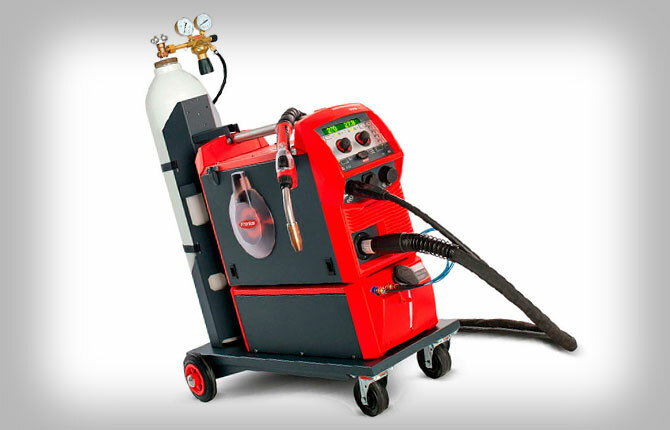
Today the market is oversaturated with offers. The designs of welding machines have become more diverse. But this made the models more perfect. At the heart of all modern welders, all the same old schemes are used, but on a new element base.
By type, devices can be divided into several basic models:
- transformer structures;
- inverter circuits;
- welding machines for DC welding;
- structures for welding in a protective gaseous environment;
- devices for spot welding;
- gas welding units.
All of the above applies only to devices whose circuit and design allows connection to a 220 V household electrical network. This is a basic limitation for all household models.
When choosing the type of welding machine (except for gas welding), it is necessary to realistically assess the capabilities of the power grid. Modern semiconductor-based models can work in a country house or in a garage, where the mains voltage can be in the range of 150-240V. Older devices with transformer voltage conversion have to be redone.
transformers
The most ancient type of welder. Actively used for over a hundred years. The basis of the device is a heavy (up to 20 kg) and powerful (up to 5 kW) transformer, which converts the mains voltage of 220 V at the input into a working variable of 50-60 V.
For high-quality welding of metal, the transformer must have a certain type of current-voltage characteristic, often steeply falling. A conventional power transformer removed from industrial equipment is not suitable for welding.
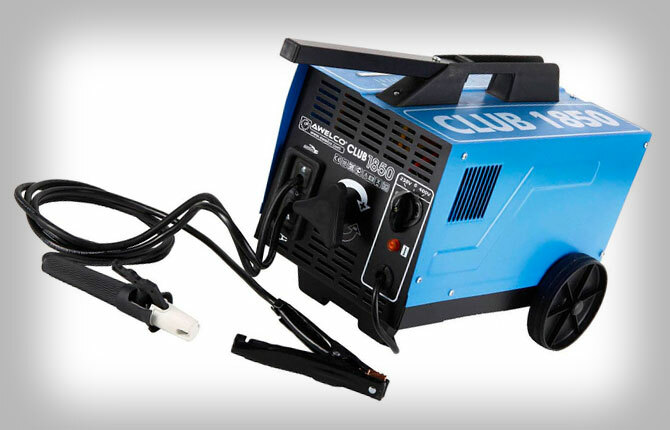
Before starting work, the welding transformer is tuned to certain characteristics - the current and intensity of the arc. By moving the ballast resistor or reactor by hand, it is possible to achieve a steeply falling voltage-current characteristic. This means that from the moment the arc is ignited, the voltage will greatly decrease with increasing current, the amount of energy is released evenly, so there will be no burns or lack of fusion.
Positive sides:
- simple design, easy repair;
- affordable price;
- high welding current - up to 250A;
- reliability.
The service life of a welding transformer wound from high-quality copper wire is 20-25 years. In practice, with careful handling, the service life is limited only by the reliability of the insulation. The wire in proprietary rubber insulation is able to provide 30-40 years of trouble-free operation.
Cons of the device:
- big weight;
- complexity of setting;
- limited use;
- strong interference generated by the transformer in the network.
It is not recommended to perform work using a transformer welder near high-rise buildings in order to avoid conflicts with residents.
Rectifiers
Certain types of materials, such as stainless steel or cast iron, are welded using direct current. This requires a rectifier. In fact, this is the same welding transformer, additionally equipped with control systems, a block of semiconductor valves that convert current from AC to DC. All types of regulators with a transformer are assembled in a compact but heavy case (10-12 kg).
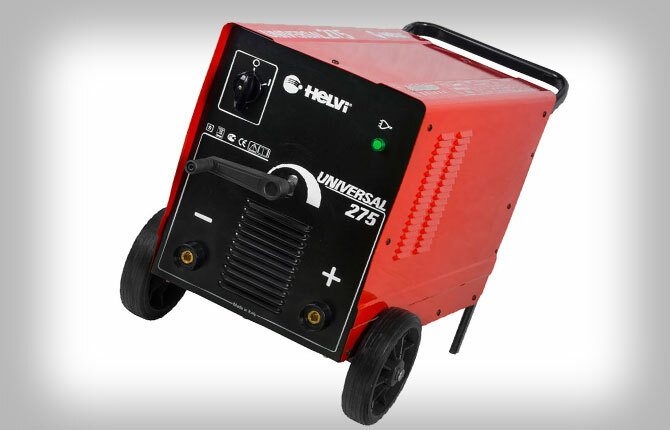
As a mode controller, a thyristor control board is used. With it, you can adjust the amount of current. The block of rectifying silicon diodes is unregulated. Type of welding current - constant.
Positive and negative sides:
Easy to set up and operate.
Does not require special types of adjustment.
Easy to repair - there are no scarce parts in the thyristor regulator.
Simple types of problems are easily fixed on their own.
You can only work with direct current, so it may be difficult to weld a thick-walled profile, certain types of rolled products.
It is difficult to cook thin-walled structures.
The thyristor board has no protection.
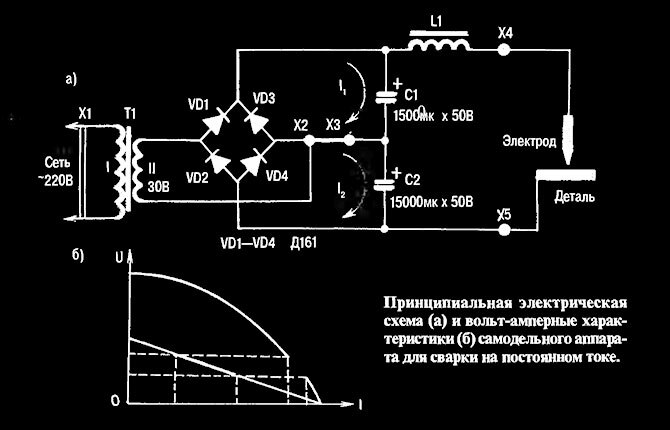
For certain types of welding work, involving a long continuous load, a magnetic shunt is used instead of a thyristor regulator, installed on the secondary winding. Opening or closing it is carried out using the handle on the front panel of the device.
The unit is considered reliable in operation, but this type of welder is not popular with amateurs due to the difficult selection of the operating mode.
inverters
This kind of welding equipment is assembled on electronic components. In the design of the apparatus, voltage conversion is provided by an electronic generator based on controlled switches. There is a transformer, but this kind of converter works with high frequency voltage. Therefore, the weight and dimensions of the device are small. The weight of the inverter rarely exceeds 5 kg.
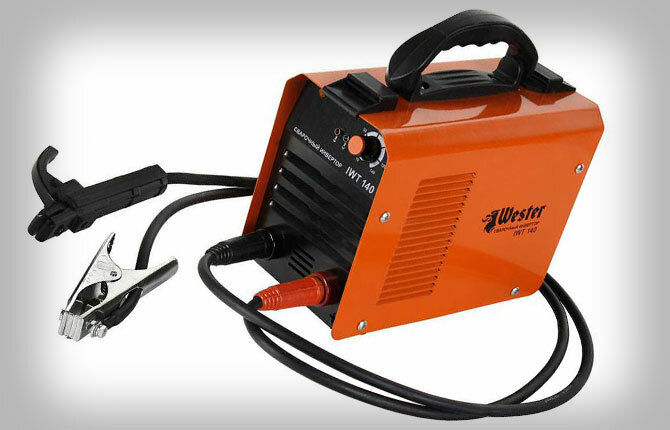
Inverter welders are assembled on an element base of two types - MOSFET transistors and newer IGBT elements. The first type of semiconductors has been produced for more than 50 years, they are distinguished by reliability and low price. There are about 20 of them in one inverter. They quickly overheat, already at 60 ℃ protection often works.
The new IGBTs can withstand temperatures up to 90℃, up to 10 pieces are required for the inverter. Such elements are more expensive and do not allow all types of repairs. The size of the semiconductor package is small, it is difficult to solder it from the board.
All types of inverter welding machines work according to the same scheme:
- the alternating current coming from the network, with a voltage of 220 V, is rectified on a block of powerful diodes;
- in the second stage, the filter eliminates noise. At the same time, this type of protection blocks interference from getting back into the network, so you can cook with an inverter even in an apartment;
- after the filter, the generator converts the direct current into alternating current with a frequency of about 100 kHz. This makes it possible to use small compact parts and elements;
- the signal from the generator is fed to a high-frequency transformer, where it is reduced to a voltage of 50-60 W, after which it is rectified at high-frequency valves.
In addition to its small size, the welding machine is interesting for the possibility of finely adjusting the current in the electric arc.
Positive sides:
- light weight;
- the ability to weld thin-walled parts;
- simple setup;
- no network interference.
Most inverters have additional options that improve the quality of welding by untrained workers. For example, turning on the Anti Stick prevents the electrode from sticking at the moment the arc is ignited. The Hot Start system increases the current and voltage at the moment of arc ignition, which makes it easier to start work.
The negative points are that the inverter requires careful handling. If improperly used, the high-frequency generator easily fails. Most types of welder repairs require the qualification of an electronics specialist.
semi-automatic
A fundamentally new type of welding machine, for decades it has been widely used in industrial production and when carrying out repair work in specialized workshops. Semi-automatic welding became available with the advent of compact inverters.
The device can have one or two cases. The first block contains an electrical converter, similar to an inverter or rectifier. In the second, a reel system for supplying copper-plated welding wire through a flexible rubber sleeve to the welding point. There is a power cable inside.
If this is a mobile portable type of apparatus, then all the elements, except for the sleeve, are assembled in one block. In addition, CO gas is supplied to the sleeve2 from a cylinder with a gas reducer.
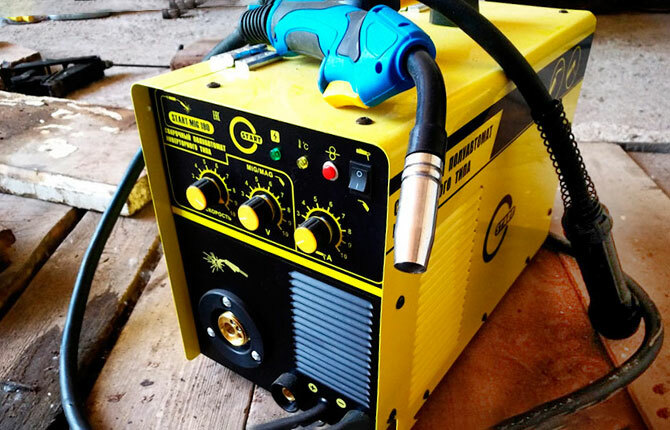
At the end of the sleeve there is a gun-torch with a key for turning on the gas and wire supply. During operation, the wire electrode protrusion is only 4-5 mm, so the welding zone is completely immersed in the shielding gas flow.
The advantage of the semiautomatic device is the high quality of the seam. All types of thin sheet steel can be welded.
Despite the fact that, according to statistics, 60% of amateur welding work is performed semi-automatically, the device has many negative aspects:
- consumables - wire and gas of good quality, are not cheap;
- heavy weight of the welding system;
- rapid filling of the workplace with carbon dioxide or carbon monoxide;
- the operation of the gas valve and the wire feed spool must be periodically adjusted.
Of all types of welding work, a semi-automatic machine justifies itself for car body repairs, the manufacture of large-volume metal tanks, and minor repairs of metal furniture.
Argon arc welding machine
Argon welding differs from other types in that it uses a torch with an argon supply nozzle and a non-consumable tungsten electrode. The remaining elements are made in the same way as in the semi-automatic, but without copper-plated wire.
The essence of the work of the argon-arc apparatus is to create a soft stable arc over the welding pool of molten metal. The melting zone is only a few millimeters. Therefore, unlike other types of welding, the seam is thin and uniform, with a small, barely noticeable wave. To compensate for the "failure" of the seam, filler material is added to the bath in the form of a rod with alloying additives.
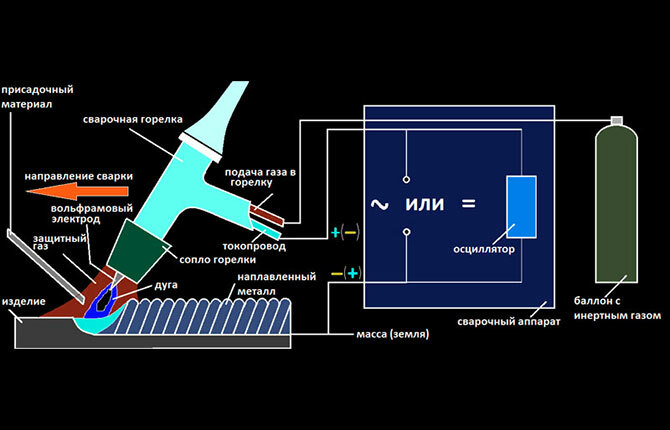
Disadvantages of using argon:
- the cost of argon is an order of magnitude greater than that of carbon dioxide;
- you need professional skills in handling argon;
- Argon sprayed into the air can cause asphyxiation or damage to the lungs.
Usually, the unit is classified as one of the types of welding machines without electrodes, but this is not entirely true. A tungsten rod with a diameter of 2-3 mm burns out slowly, but it also needs to be changed periodically.
The advantage of an argon-arc welding machine is the ability to weld thin (<1 mm) parts without overheating or deformation of the product. In addition, non-ferrous metals, especially aluminum and copper, are boiled with argon. The strength and tightness of the welded seam is only slightly inferior to the original metal.
Spot welding machine
Because of the pliers protruding from the body, it does not look like a traditional welder. The welding machine is used to perform one operation - welding two thin sheets of steel at one point.
The principle of operation is simple:
- blanks are folded in a package and fixed with a clamp with gaskets;
- a place for the welding point is selected;
- bring the tongs to the point, press them with the force of the hands so that reliable electrical contact is provided between the electrodes and the steel;
- steel heated by current passes into a plastic state and is welded.
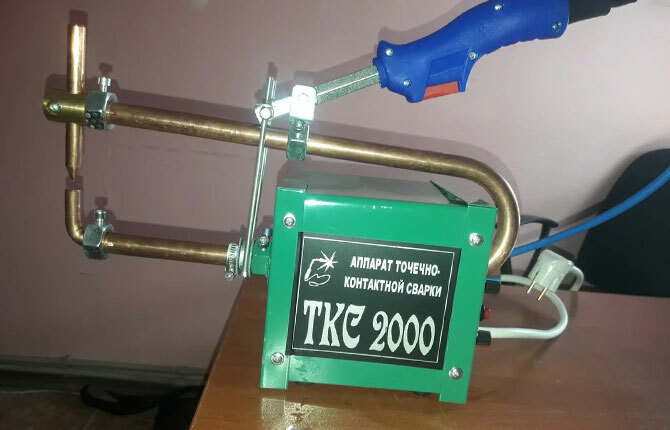
The tongs must remain compressed. The device operates from a conventional 220 V network and does not require special protective clothing, masks or additives. Welding speed reaches 10 points/min.
Pros and cons:
High connection speed.
Lack of consumables and welding cable.
No emissions of gases and metal vapors.
The case with tongs during operation has to be kept on weight.
You can not work with all types of steels - mainly black and low-alloyed ones are welded.
The tool is specialized, designed to work with sheet metal.
Apparatus for gas cutting and welding
The gas welding plant consists of two high-pressure cylinders, one of which is filled with oxygen, the second with hydrocarbon gas. It used to be acetylene, now methylene or propane is used. The weight of the cylinders is 10-12 kg. The gas outlets from the cylinders are fed through pressure reducers through hoses to the gas burner, where the mixture is mixed and burned.
Gas welding is considered the most versatile of all types of welding. It can be applied to:
- gas cutting and welding of steel. If you have skills, you can weld both massive parts and thin-walled sheets;
- thermal cleaning and roasting of metal surfaces of all kinds and types of products;
- for heat treatment, heating before hardening, tempering, joining parts by shrink fit;
- welding and soldering small parts with hard solders.
Gas welding does not require connection to the electrical network, but gases will have to be pumped in at a specialized station. Refueling is cheap. Cylinders will need to be pressure tested before filling.
Gas welding is the only type of welding that requires prior training in handling the torch, gearbox, valves and cylinders.
Plasma welding
State of the art welding technology. The device consists of a block in which a welding inverter and an air compressor are placed. The purified air stream, sometimes enriched with water vapor, is fed into the hand burner. Inside the burner there are two electrodes of a special shape, an electric arc burns between them. The air flow is heated to the state of plasma and blown out through a cooled nozzle onto the surface to be welded.
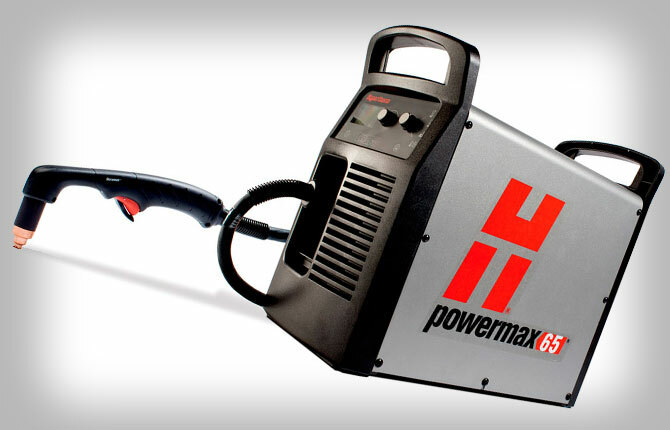
Plasma can cut all kinds of materials, weld any metals and alloys. The seam is thin and strong, the quality depends on the correctly selected filler rod.
Plasma welding machines are mainly used for welding thin-sheet stainless steel, cast iron, copper, precise cutting of sheet blanks.
What are the parameters to choose one or another type of welding machine
The decision must be made based on the practice of application. A certain model of the welding machine was developed for a certain type of task. If you just want to have a tool in your house with which you can weld a bicycle frame, pipe, bracket, then a Chinese welding machine in the form of a drill will do. Cooks for a maximum of 5 minutes, but it is quite possible to boil a seam of 3-4 cm.
On the other hand, the Chinese “drill” is compact and lightweight, so it can easily find a place even in an apartment.
Option 1. Nutrition
The first thing to know when choosing a welding machine is the condition of the electrical network. If in a private house, in a garage, in a country house the voltage is stable at least 210 V, then you can buy a rectifier. The transformer is recommended only for cases when welding work is carried out constantly in one place, with the same material.
If the power "jumps", then an inverter or plasma will do. In the latter case, you may have to buy a stabilizer. It is also not good to perform welding work with an inverter machine with a “jumping” voltage, as the efficiency drops and the electronics overheat. But the inverter is the only type of welding machine that can work with unstable power.
Option 2. Welding current range
Doesn't really matter. All types of modern welders have a range of 20-130A. This is enough for domestic work.
An exception may be a transformer or rectifier. Their secondary winding consists of one or two winding sections, by switching which, it is possible to reduce or increase the welding current. In addition, it will be necessary to purchase a reactor and a set of ballast resistors for the secondary winding. If you know how to choose the right ballast for the secondary winding to limit the current, then the quality of the seam will be perfect.
Option 3. Electrode diameter
A universal solution would be to buy a medium power inverter. A high-quality device with a built-in cooling system is able to work with any electrode up to 5 mm in diameter. You can make tacks with a deuce, a four or five - the main seam.
| Electrode diameter, mm | Metal thickness, mm | Welding current, A |
| 1,6 | 1-2 | 25-50 |
| 2 | 2-3 | 40-80 |
| 2,5 | 2-3 | 60-100 |
| 3 | 3-4 | 80-160 |
| 4 | 4-6 | 120-200 |
| 5 | 6-8 | 180-250 |
| 5-6 | 10-24 | 220-320 |
| 6-8 | 30-60 | 300-400 |
If the welding machine is needed for specific types of work, then it is better to use a good rectifier. For example, when welding metal frames from a steel profile or a corner, the inverter welder will quickly overheat and turn off.
It is impossible to cook with a reduced direct current, the depth of penetration, and, accordingly, the strength of the connection, will turn out to be small, although the seam may look perfect. For work with a 5 mm electrode, a welding transformer would be the best option.
Option 4. Open circuit voltage
For beginners, inverters are recommended. They have several built-in features that prevent sticking of the electrode and stabilize the arc during ignition. In this case, the electronics artificially raises the open circuit voltage above 60 V at the beginning of the process, then instantly reduces it to 45-50 V, while simultaneously increasing the current.
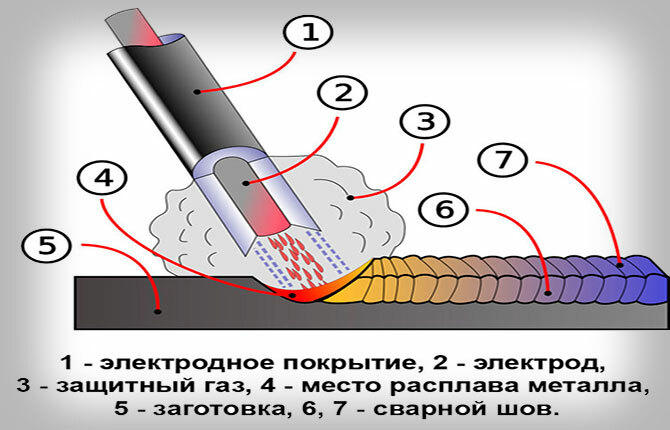
The only negative is that the built-in “anti-sticking” and “arc stabilizer” systems often fail, then it can be more difficult to cook with an inverter apparatus than with a rectifier.
In simple transformer models, the open circuit voltage is 50-60 V, depending on the electrode used. For semi-automatic machines, the idle speed is even lower - up to 35 V.
Option 5. Working cycle
Typically, the manufacturer of welding equipment indicates in the passport the parameters “working time at maximum current” and “cooling time”. For an average inverter, the duty cycle is 10 minutes of operation and 5-6 minutes of cooling with a good fan. For amateur work, this is enough. For welding installation, the duty cycle corresponds to the burning time of one or two electrodes.
For transformer and rectifier, the cycle depends on the diameter of the electrode and the operating current. Semi-automatic, argon and plasma devices are limited by the gas pressure at the outlet of the reducer.
Option 6. Machine weight
The best indicator for portable options, inverter models - 3-5 kg, rectifiers and plasma - up to 10 kg. Buying heavier welding machines makes sense if the equipment is used in professional activities.
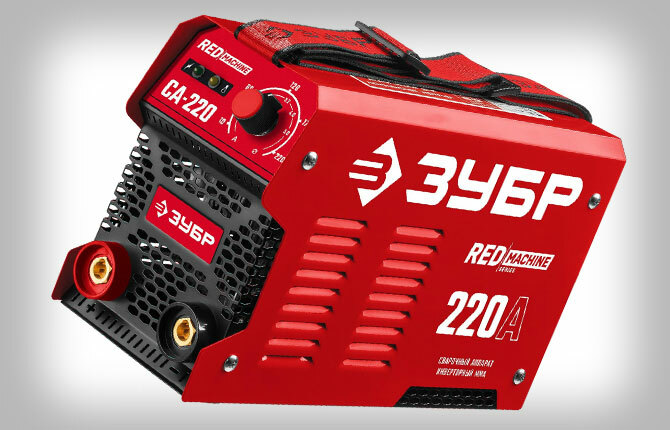
The increased weight of the inverter or rectifier indicates that the manufacturer did not stint on the installation of cooling radiators. For a transformer, a large weight often indicates good quality of the core, copper conductors of the primary and secondary windings.
For other types of welding machines, weight does not matter, since they are tied to gas cylinders and are used in stationary mode.
Option 7. The maximum power of the device
The welder must be powerful. The optimal power of the welding machine for domestic work is 3-5 kW for transformers, rectifiers, spot welding systems, 3-4 kW for inverters. For semi-automatic, argon and plasma models - 2-2.5 kW.
There are many tricks and ways to reduce the welding current, adapt the operation of the semiautomatic device at minimum power, and weld thin metal. But if the power of the welding machine, regardless of its type, is not enough to weld the metal to the full depth, then this is a disaster.
The idea to boil a seam in several passes is good, but not for the household level, as it requires professional training, experience and knowledge. The more powerful the welding machine, the longer the service life.
Option 8. Cable length and cross section
For electrical devices with transformer voltage conversion, the cross-section and length of cables, or in other words, welding "hoses", is a problem. The only exceptions will be semi-automatic, plasma, argon and spot welding.
Most manufacturing companies complete their products with "hoses" of 2.5-3 m, with a cross section of 30-50 mm2. This is enough to weld a small seam on a workbench, provided that the welding machine is on the floor under your feet.
If we are talking about more complex work, for example, repairing cars, welding a corner on the roof of a canopy, then the length of the “welding hoses” should be 3-5 m, with a cross section of at least 100 mm2 in heat-resistant rubber insulation. And even such a cable heats up to 70-100 ℃ after 10-15 minutes of intensive work.
Option 9. Type of current
Ideally, the design of the welding machine should provide operation on alternating and direct current. The variable is used for welding ferrous metals, the constant is used for welding cast iron, stainless steel, and sometimes thin-walled structures.
If there is no way to choose, then it is better to take a welding machine with direct current.
Option 10. Additional indicators
In addition to technical data, when choosing a welding machine, you need to pay attention to endurance and workmanship. When choosing, you can collect reviews about different types and models, see the opinion of professionals. If the welder has a reputation for being unkillable, then this is the best recommendation for selection.
The durability of a welding machine is directly related to the quality of workmanship and the parts used. For example, if instead of a special fan there is a 120 mm computer cooler in the case, then it is better to refuse the purchase.
What types of welding machines are suitable for home
An inverter with a power of 3 kW is suitable for an ordinary man in the street. Fans of making homemade products choose devices of a similar type, but with a little refinement. They change the fan, toggle switches, put longer and thicker welding hoses.
For an apartment, an inverter device of 1.8-2.5 kW is enough. This is enough to weld hinges on a door or a bicycle frame. For a private house or cottage, the best solution would be an inverter rectifier up to 5 kW.
If you are engaged in technical creativity, then plasma will be the best solution, it is an expensive and versatile welding machine, but it will cope with any materials.
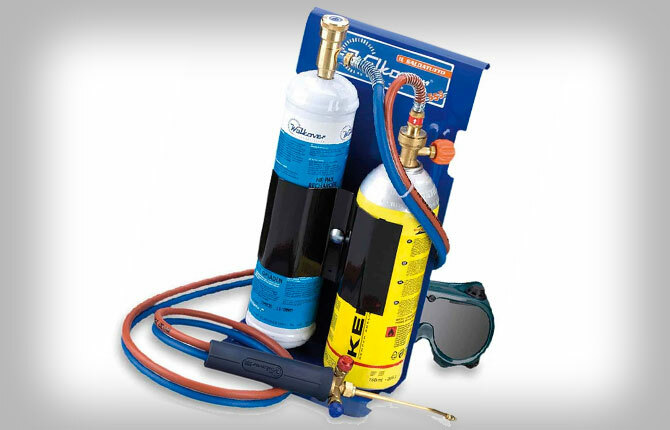
Combinations of several types of welding machines are possible. Refrigerators use gas or argon welding. To repair cars, you will need a set of a semiautomatic device and a gas burner. If you repair the body, then also spot welding.
Argon welding machines are used to repair car engines, aluminum utensils and frames of double-glazed windows of all kinds.
Popular manufacturers
There are many models of welding machines, it is difficult to understand them, so you have to focus on the reputation and features of welder manufacturers.
Let's look at the most popular manufacturers of welding machines and create our own rating.
Aurora PRO
Lightweight, compact, hold the arc well. Welding machines are assembled from components from China and Europe. Comes with a storage case.
Of the shortcomings, the poor quality of the welding cables, the handles break. On the plus side, it comes with a 2-year warranty.
BlueWeld
Italian brand, long known in Russia. Welding machines of all kinds are assembled in Italy. The price is moderately high. Conventional rectifiers are in demand. Inverters cost almost twice as much as competitors.
Brima
German brand, specialization - welding machines of all kinds. Components are produced in Southeast Asia, assembly - in Europe. The quality is not bad, it is distinguished by endurance and the ability to work at maximum currents for a long time.
Among the shortcomings - the handles of the controls easily fail, the high cost of inverters.
Elitech
Russian brand. But welding machines of all kinds are produced in China. Differ in the increased weight and short cables. Control knobs often break. The quality of welding is high, the cost is lower than that of European counterparts. Repaired badly.
Eurolux
The main part of the company's product range consists of welding machines with an inverter converter. Great option for an apartment. Beautiful design, good stitching quality. There are many fakes on the market.
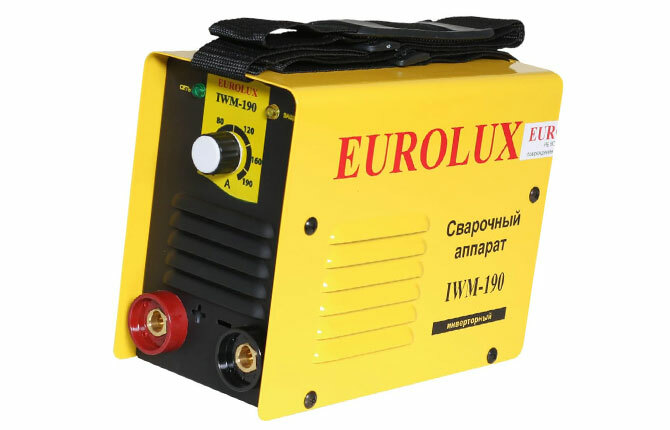
FoxWeld
Italian trade mark for welding machines of all kinds. All production and assembly is located in China. Welders are characterized by high reliability of electronics, low quality of handles, welding hoses. The design is not the best. There is a network of warranty workshops in Russia.
Fubag
Company with registration in Germany and production in China. Produces mainly inverters. Weld quality is average. The product is clearly overpriced.
Hardware study at a high level, welders are well assembled. There is a network of warranty workshops, but repairs are expensive.
Kedr
A Russian company that manufactures all types of welding equipment, from argon welding to inverters and semi-automatic devices. Warranty two years. The level of design is "C grade".
Most products are characterized by increased weight, poor quality of welding cables. Welding quality is high, works flawlessly even in extreme weather conditions.
Patriot
Well-known American brand. It produces inverter welders, semiautomatic devices and argon. Warranty 1 year and 3 years.
Welding machines are superior in quality and reliability to European brands.
redverg
American manufacturing company. It produces welding machines of all types - professional and amateur level. The products on the market are mainly represented by high-quality inverter models and carbon dioxide semi-automatic machines. It is sold at a price below the average, it is distinguished by reliability and high quality of the weld.
Resanta
The brand is registered in Latvia, electrical equipment is produced in China. The main sales of all types of welding equipment are carried out in Moscow. The quality of the devices is noticeably inferior to European and American ones, but better than Chinese ones.
Stavr
Russian trade mark of welding rectifiers and inverter devices. The Stavr technique is distinguished by a well-thought-out layout, but low reliability of mechanical wire feed.
The welding seam is not satisfactory, but to work with Stavr you need to have at least the initial skills of a welder.
Svarog
Russian company. Produces welding equipment with Shenzhen Jasic Technology. Mainly SKD is carried out from imported components, so the quality of the main types of welding machines is high.
Wester
Trademark registered in the UK. The company of the same name manufactures and sells all types of welding equipment, with a warranty repair of its products.
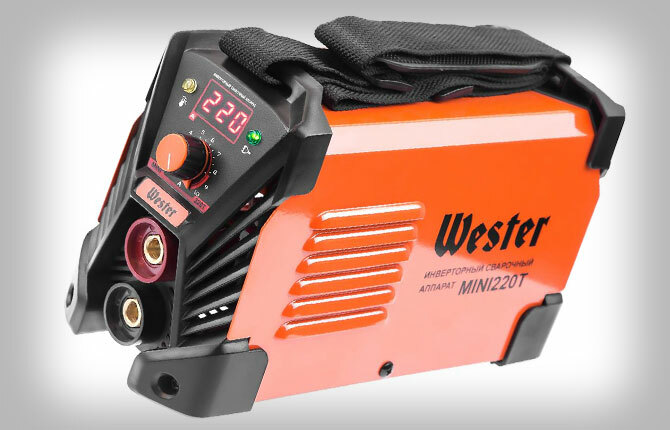
The level of quality is evidenced by the fact that the devices have a guarantee of up to 5 years.
Rating of the best welding machines from the site sovet-ingenera.com:
Aurora PRO
1
Wester
1
BlueWeld
0
Brima
0
Eurolux
0
FoxWeld
0
Fubag
0
Kedr
0
Patriot
0
redverg
0
Resanta
0
Stavr
0
Svarog
0
Elitech
-1
All major types welding machines have long been optimized in design and repeatedly tested in practice. However, even well-known brands have problems. Therefore, before buying, you need to conduct an analysis, with a comparison of the negative and positive aspects of the selected models.
FUBAG IQ 160 welding inverter. First impressions after purchase: video.
Share your experience of choosing such devices in the comments. Bookmark the article, share it on social networks.


